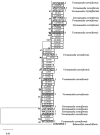High Diversity and Prevalence of Potentially Pathogenic Free-Living Amoebae in Water Sources from Castilla y León, Spain
- PMID: 40732685
- PMCID: PMC12300931
- DOI: 10.3390/pathogens14070637
High Diversity and Prevalence of Potentially Pathogenic Free-Living Amoebae in Water Sources from Castilla y León, Spain
Abstract
Free-living amoebae (FLA) such as Acanthamoeba spp., Balamuthia mandrillaris, Naegleria fowleri, Sappinia pedata, Vermamoeba vermiformis and Vahlkampfia spp. are causal agents of deadly and/or disabling infections in humans. Despite recent data showing an increase in infection cases worldwide, studies on the prevalence of these emerging pathogens in water sources are scarce. Moreover, climate change is believed to facilitate the expansion and persistence of these environmental pathogens, further emphasizing the need for comprehensive surveillance. Therefore, the current study investigates the variety and abundance of free-living amoebae in different water sources in the autonomous community of Castilla y León, Spain, during different seasons of the year. Vermamoeba vermiformis was the most prevalent species and was detected in rivers, swamps, irrigation waters, swimming pools and recreational fountains. Moreover, genera such as Acanthamoeba and Naegleria and Vahlkampfia were also identified. This study highlights the diversity of FLA in the region and their relationship with local water characteristics. Given that certain FLA species are opportunistic pathogens, these results emphasize the necessity of monitoring this area and water sources.
Keywords: Acanthamoeba spp.; Castilla y León; Spain; Vermamoeba vermiformis; monitoring; water.
Conflict of interest statement
The authors declare no conflicts of interest.
Figures











Similar articles
-
Global prevalence of free-living amoebae in solid matrices - A systematic review with meta-analysis.Acta Trop. 2023 Nov;247:107006. doi: 10.1016/j.actatropica.2023.107006. Epub 2023 Aug 25. Acta Trop. 2023. PMID: 37633571
-
Multiplex Real-Time Polymerase Chain Reaction Assay To Detect Acanthamoeba spp., Vermamoeba vermiformis, Naegleria fowleri, and Balamuthia mandrillaris in Different Water Sources.Am J Trop Med Hyg. 2024 Aug 6;111(4):785-790. doi: 10.4269/ajtmh.24-0028. Print 2024 Oct 2. Am J Trop Med Hyg. 2024. PMID: 39106847
-
Uncovering the Diversity of Pathogenic Free-Living Amoebae in Freshwater Environments of Ghana: A Combined Culture Enrichment and Metabarcoding Approach.J Eukaryot Microbiol. 2025 Jul-Aug;72(4):e70032. doi: 10.1111/jeu.70032. J Eukaryot Microbiol. 2025. PMID: 40685816
-
Isolation and Molecular Identification of Pathogenic Free-Living Amoebae from Environmental Samples in Tenerife, Canary Islands, Spain.ACS ES T Water. 2025 May 2;5(6):2861-2869. doi: 10.1021/acsestwater.4c00573. eCollection 2025 Jun 13. ACS ES T Water. 2025. PMID: 40535166 Free PMC article.
-
Prevalence of free-living amoebae in swimming pools and recreational waters, a systematic review and meta-analysis.Parasitol Res. 2022 Nov;121(11):3033-3050. doi: 10.1007/s00436-022-07631-3. Epub 2022 Aug 30. Parasitol Res. 2022. PMID: 36040629 Free PMC article.
References
-
- Vaerewijck M.J.M., Baré J., Lambrecht E., Sabbe K., Houf K. Interactions of Foodborne Pathogens with Free-living Protozoa: Potential Consequences for Food Safety. Compr. Rev. Food Sci. Food Saf. 2014;13:924–944. doi: 10.1111/1541-4337.12100. - DOI
MeSH terms
Grants and funding
LinkOut - more resources
Full Text Sources
Miscellaneous

